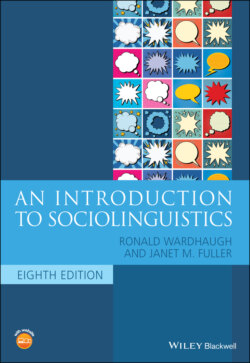Читать книгу An Introduction to Sociolinguistics - Ronald Wardhaugh, Janet M. Fuller - Страница 29
The Interdisciplinary Legacy of Sociolinguistics
ОглавлениеSociolinguistics has grown out of ideas presented by scholars from different traditions, most notably linguistics, sociology, and anthropology, although some key figures in its development also came from the field of education (see Wodak et al. 2011 for a more detailed overview of this). There is a general distinction between micro‐sociolinguistics and macro‐sociolinguistics (which has also been called the sociology of language). In this distinction, macro‐sociolinguistics includes such topics as language policy and planning, societal patterns of language use (especially in multilingual contexts) and intercultural communication, while micro‐sociolinguistics looks, as the name implies, at the smaller details of interactions – the structure of conversation, the use of specific linguistic variables and their variants, and the variation of these aspects of language across different social contexts.
A further distinction which is sometimes made is that between sociolinguistics and linguistic anthropology. A number of scholars (Duranti 2003; Gumperz and Cook‐Gumperz 2008; Bucholtz and Hall 2008) have noted the fuzziness of the distinction between these two fields, arguing that there is considerable overlap in theory, themes, methodologies, and history. Ethnography of communication (which will be discussed in detail in chapter 6) has long been an area of overlap between these two fields (and others); this approach examines languages as a system of cultural behavior. Current approaches to the study of identities and language ideologies also blur the distinction between sociolinguistics and linguistic anthropology. In chapter 6, we will discuss several ethnographic approaches which focus on language in society, including ethnography of communication. This is qualitative research and thus methodologically very different from quantitative variationist work; it also tends to address the question of the social meaning of language use less in terms of correlation with the social categories associated with the language user, and more in terms of how people use language to carry out their social lives (including but not limited to positioning themselves as members of particular social categories). Further, other approaches to discourse analysis (the broad term used to discuss methods that look at language use at a level beyond the utterance) which have similar aims will be introduced in chapter 7.
There is also a growing amount of work originally called critical sociolinguistics (Singh 1996; Kress 2001) but now often termed critical discourse studies (Wodak and Meyer 2015; van Dijk 2009). This approach takes what can be called an ‘interventionist’ approach to matters that interest us; we will discuss its findings in more detail in the section on Critical Discourse Analysis in chapter 7, and in Part IV of the book on Sociolinguistics and Social Justice. Rooted in critical theory, research in this vein is concerned with looking at power structures and the reproduction of inequalities. This work focuses on how language is used to exercise and preserve power and privilege in society, how it buttresses social institutions, and how even those who suffer as a consequence fail to realize that many of the things that appear to be ‘natural’ and ‘normal’ are culturally constructed and not inevitable; it is power relations in society that determine what is defined as ‘normal.’ Critical discourse studies thus seek to bring such power relations to light, with the aim of bringing more social equity.
This is very much an ideological view, and its proponents maintain that all language use is ideological as are all investigations, that is, that there is no hope of an ‘objective’ or ‘neutral’ sociolinguistics. Indeed, neutrality is not sought within critical discourse studies. As noted by Blommaert: ‘it is not enough to uncover the social dimensions of language use. These dimensions are the object of moral and political evaluation, and analysing them should have effects in society: empowering the powerless, giving voices to the voiceless, exposing power abuse, and mobilising people to remedy social wrongs’ (2005, 25). It is important to note that this perspective of the societal utility of sociolinguistics is not new or solely in the area of critical discourse studies. Linguists have long seen the importance of weighing in on social issues connected to their research; a well‐known example is the testimony of linguists about the status of so‐called Black English and the educational rights of its users in 1979 (Labov 1982). Recent discussions of engagement in sociolinguists are a call to go beyond mere consciousness raising (see Lewis 2018; Labov 2018; Rickford 2018; and Rickford and King 2016 for a deeper discussion of this).
The intellectual history of sociolinguistics and linguistic anthropology also reflects broader ideas and movements of its time. Heller and McElhinny (2017) address how political and economic ideologies and events, such as colonialism and capitalism, have influenced how language is studied and what conclusions are drawn from sociolinguistic studies. Block (2018, ix) notes that sociolinguistics increasingly includes social theory more broadly. His text on political economy in sociolinguistics addresses the study of topics such as English world‐wide (which we will pick up in chapter 13), the language of tourism, language in the workplace, and the importance of social class in not just how we speak but also discourses about social groups and their inherent social value. Further, sociolinguists and linguistic anthropologists have often been involved in language revitalization movements and language policy and planning, topics which will be addressed in chapter 13.
As can be seen by this brief introduction, the study of sociolinguistics has grown out of an interest in the role of society in how we use language to encompass a concern for how language is part of the construction of social realities. This volume seeks to present contemporary research but acknowledge the history of the field, presenting theories and findings which contribute to our understanding of language in society in different ways.
